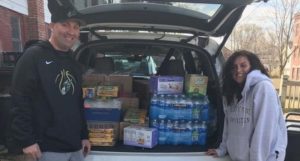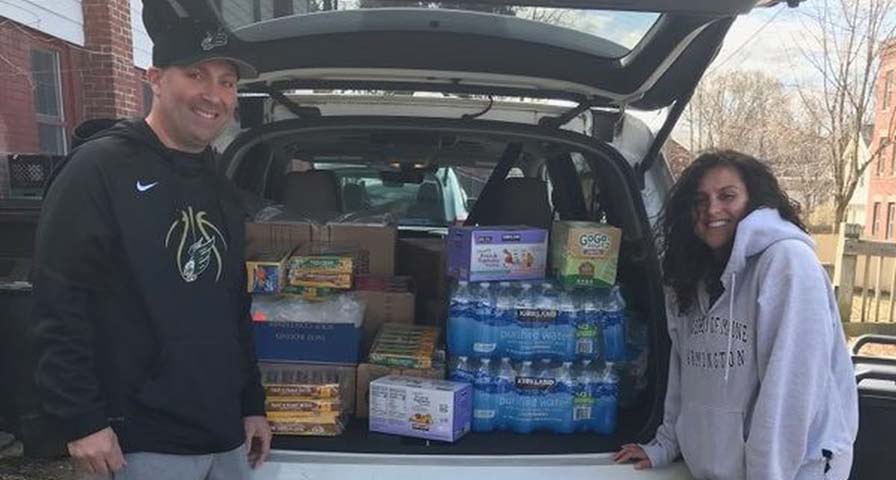Originally published June 3, 2020 in the Journal Inquirer.
By Adam Betz
Some subjects are better suited for distance learning than others.
Physical Education isn’t one of them, but that hasn’t stopped the Enfield school system.
Providing students opportunities to remain engaged and active during the COVID-19 pandemic has been the priority for Brie Quartin, district coordinator for physical education and health.

Enfield coach Jay Gaucher, pictured collecting items to donate to an area food back previously, encourages students learning from home to create goals and work toward them to maintain and improve their physical fitness.
“We want our students to remain engaged in physical activity,” Quartin said. “We want them to schedule time away from their screens to rejuvenate and reenergize. We want them to be cognizant and reflective of all the dimensions of wellness — physical, emotional, social, spiritual and intellectual health — and to set goals and boundaries for themselves so that they can achieve a healthy balance during this time.”
Enfield stopped in-school learning on March 12, with virtual classes beginning on March 15. Despite going virtual, Enfield’s PE curriculum hasn’t really changed during the pandemic.
“It looks very similar to our traditional learning system in the sense that our national standards provide the blueprint for both academic content and lesson pacing, which helps ensure curricular continuity even during distance learning,” Quartin said. “There might be differences in the way virtual instruction looks, but our mission as a department is to create performance tasks that are authentic and relevant.”
Though the adjustment has been big, Quartin has seen positives emerge from distance learning.
“Many students are now taking a greater responsibility for their learning,” Quartin said. “They’re appreciating the freedom to create their own schedules and work at their own pace.”
Because students have different levels of access to fitness equipment at home, they are choosing which activities they are doing.
“One of the things we’ve done in our Phys Ed. portion is they had to create two goals and how they wanted to achieve it,” Enfield High physical educator Jay Gaucher said. “So for example, we had one student and one of his goals was he wanted to be able to run continuously for 20 minutes. So, he put a plan in place.”
Gaucher, who is also the girls basketball and baseball coach at Enfield High, said that many of the students across his four PE classes have focused on fitness aspects, including playing basketball and hiking. The high school has also created an Instagram page for students, featuring challenges between teachers and other activities.
Similar things are taking place at the elementary and middle schools.
“Our first middle school assignment asked for students to analyze their Connecticut Physical Fitness scores and create a S.M.A.R.T goal for a component of fitness they would like to improve,” Quartin said. “They then developed a fitness plan that would help them achieve their fitness goal.”
As students are doing their activities at home, the department has had to get creative in finding ways to make sure students are doing their work.
“At the secondary level, we have established weekly benchmarks for the students so that we’re able to monitor their progress,” Quartin said. “The teachers have done a fantastic job providing consistent and specific feedback to their students to make sure that student work is congruent with those weekly benchmarks and the project rubrics.”
That ability to give feedback has been a “blessing in disguise” for Gaucher.
“I think during this time, I have gotten more questions from students about their fitness and how they can go about reaching and achieving goals than when we were in the regular classroom,” he said. “Just because I think they’re home now and they’re like, ‘Well what can I do?’ For me, I’ve been enjoying that part of being able to give feedback to students about their fitness and what they can do.”
One of the biggest things Gaucher misses about in-school teaching is the daily interaction with his students and peers. But students are also missing that interaction.
Gaucher recalled seeing one of his students at Dunkin’ Donuts during the pandemic.
“He goes, ‘Never thought I’d say it, but I really miss going to school,’ ” Gaucher said. “So, I think there’s those underlying things of kids are missing their normal routine. But I think for me, the biggest thing is them understanding that they are responsible for their learning and also understanding that there are people that care for them above and beyond just their education. I think they see that a lot now.”
Because of the department’s efforts, student engagement in PE assignments is at the same level as other subjects, Quartin said.
“Particularly with our younger students, these are often the first assignments that the kids choose to open up and do each morning,” Quartin said. “I actually had a parent that commented that their child said that opening up the PE assignment felt like Christmas morning. So for me, that’s a really big deal. What greater testimony to what we do than to be on-par with Santa Claus?”
Quartin doesn’t know what gym classes will look like when students return to school.
“It’s difficult to comment on any re-entry plans for in-school learning as we’ve not yet received all the guidelines and protocols from the state level,” Quartin said. “So, I’m hoping to get more concrete information in the upcoming weeks so that we can begin planning for safe and meaningful instruction in the fall.”
But right now, Enfield students seem to be enjoying PE classes more than ever.
“I think it’s important to notice and listen to the message that the students are conveying to us,” Quartin said. “They’re letting us know that they value physical education.”
Seeking information about IHT's Remote Learning program?




